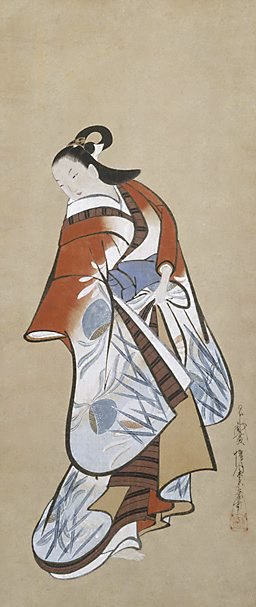-
Details
- Other Title
- Bijin
- Alternative title
- Tachi bijin
- Place where the work was made
-
Japan
- Period
- Shôtoku era 1711-1715 → Edo (Tokugawa) period 1615 - 1868 → Japan
- Date
- 18th century
- Media categories
- Scroll , Painting
- Materials used
- hanging scroll: ink and colour on silk
- Dimensions
- 107.5 x 46.0 cm image; 203.5 x 58.0 x 62.0 cm scroll
- Signature & date
Signed l.r., Japanese [inscribed in red ink] "Kaigetsudo Anchi [artist's seal]". Not dated.
- Credit
- Bequest of Kenneth Myer 1993
- Location
- Not on display
- Accession number
- 595.1993
- Copyright
- Artist information
-
Kaigetsudō Anchi
Works in the collection
- Share
-
-
About
The art of the floating world ('ukiyo-e') had two main subjects: the courtesans of the pleasure quarters and Kabuki actors. The portrayal of courtesans was a special category of painting termed 'bijin-ga', literally "paintings of beautiful women". In 'bijin-ga', an individual's personality was conveyed not through facial expression, but by pose, gesture, and the choice of colour and pattern for the kimono. The 'bijin' of these paintings were more than "pin-ups", they were symbols of a feminine ideal that transcended mere physical beauty. A high-ranking courtesan was expected to display a great aesthetic sensitivity and was esteemed not only for her sensuality, gracefulness and the unsurpassed feelings for colours and design in her clothing, but also for her skills at poetry, song, music and dance. The statuesque 'bijin' of the Kaigetsudô school is an 'ukiyo-e' classic: a single, standing figure against a blank ground, her figure defined by strong, sweeping outlines. This beauty, like all 'bijin-ga' is a fashion plate: her hairstyle dates her to the Kyôhô period (1716 - 36) and the viewer can be sure that her kimono with its refreshing pattern of reeds and shells, is of the latest fashion textile design. The most important assets of the courtesans were their hair and their kimono. They were forbidden to wear socks, and had to go barefoot even in the coldest winter. The inscription reads: 'Japanese-for-fun-only painting by Anchi, the last leaf of Kaigetsudô.'
AGNSW Collections, 1994, p. 225.
-
Places
Where the work was made
Japan
-
Exhibition history
Shown in 3 exhibitions
The Floating World: Japan's World of transient pleasures, Art Gallery of New South Wales, Sydney, 25 May 1994–17 Jul 1994
Great gifts, great patrons, Art Gallery of New South Wales, Sydney, 17 Aug 1994–19 Oct 1994
Beauty and Desire in Edo period Japan, National Gallery of Australia, Canberra, 06 Jun 1998–09 Aug 1998
-
Bibliography
Referenced in 8 publications
-
Edmund Capon, Look, 'Asian ambitions', pg. 12-13, Melbourne, Oct 2000, 12 (colour illus.), 13.
-
Sue Ebury, The many lives of Kenneth Myer, Melbourne, 2008, (colour illus.). seventh image between pages 464 and 465
-
Jackie Menzies (Editor), The Asian Collections Art Gallery of New South Wales, 'The Floating World', Sydney, 2003, 246 (colour illus.).
-
Jackie Menzies, Orientations, 'Japanese Figure Painting: From the Public to the Personal', pg. 114-119, Hong Kong, Sep 2000, 117 (colour illus.). fig.6
-
Jackie Menzies, AGNSW Collections, 'Asian Art - India, South-East Asia, China, Tibet, Korea, Japan', pg. 173-228, Sydney, 1994, 224 (colour illus.), 225.
-
Jackie Menzies, The Floating World: Japan's world of transient pleasures, Sydney, 1994, back cover (colour illus.). cat.no. C14
-
Jackie Menzies, TAASA Review, 'The Art Gallery of New South Wales", Sydney, Mar 1998, 10 (colour illus.).
-
Tadashi Kobayashi, Imaging the floating world: Essays on ukiyoe prints and paintings of the Edo period, Bunkyo-ku, 2009, 28 (colour illus.). cat.no. 10
-
